计算机毕业设计-基于web2.0的服装库存系统
基于java web校园物品交易系统设计和实现 任务书内容
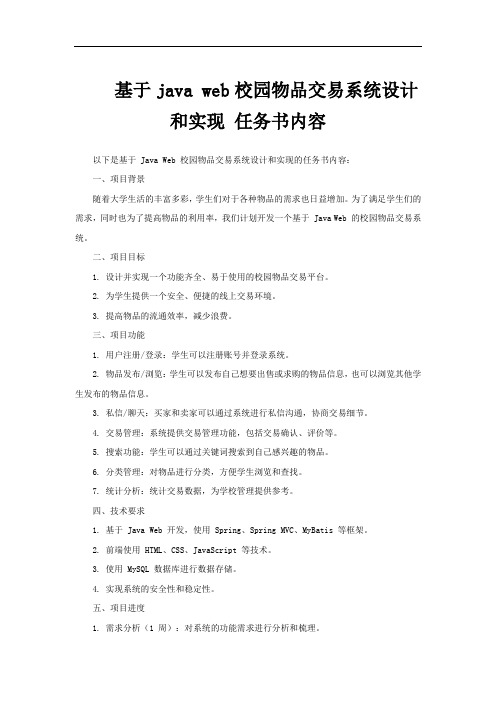
基于java web校园物品交易系统设计和实现任务书内容以下是基于 Java Web 校园物品交易系统设计和实现的任务书内容:一、项目背景随着大学生活的丰富多彩,学生们对于各种物品的需求也日益增加。
为了满足学生们的需求,同时也为了提高物品的利用率,我们计划开发一个基于 Java Web 的校园物品交易系统。
二、项目目标1. 设计并实现一个功能齐全、易于使用的校园物品交易平台。
2. 为学生提供一个安全、便捷的线上交易环境。
3. 提高物品的流通效率,减少浪费。
三、项目功能1. 用户注册/登录:学生可以注册账号并登录系统。
2. 物品发布/浏览:学生可以发布自己想要出售或求购的物品信息,也可以浏览其他学生发布的物品信息。
3. 私信/聊天:买家和卖家可以通过系统进行私信沟通,协商交易细节。
4. 交易管理:系统提供交易管理功能,包括交易确认、评价等。
5. 搜索功能:学生可以通过关键词搜索到自己感兴趣的物品。
6. 分类管理:对物品进行分类,方便学生浏览和查找。
7. 统计分析:统计交易数据,为学校管理提供参考。
四、技术要求1. 基于 Java Web 开发,使用 Spring、Spring MVC、MyBatis 等框架。
2. 前端使用 HTML、CSS、JavaScript 等技术。
3. 使用 MySQL 数据库进行数据存储。
4. 实现系统的安全性和稳定性。
五、项目进度1. 需求分析(1 周):对系统的功能需求进行分析和梳理。
2. 设计阶段(2 周):进行系统的架构设计、数据库设计和界面设计。
3. 开发阶段(6 周):根据设计文档进行系统开发。
4. 测试阶段(2 周):对系统进行功能测试、性能测试和安全测试。
5. 上线运行(1 周):将系统部署到服务器上,正式上线运行。
六、项目团队1. 项目经理:负责项目的整体规划和协调。
2. 开发人员:负责系统的设计和开发。
3. 测试人员:负责系统的测试和质量保证。
以上是基于 Java Web 校园物品交易系统设计和实现的任务书内容,可根据实际需求进行调整和扩展。
毕业设计(论文)-基于JAVA的商品库存管理系统设计与实现模板
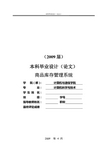
(2009届)本科毕业设计(论文)商品库存管理系统2009 年 4 月摘要本论文着重论述了库存管理系统开发时的主要设计思想及系统实现的详细过程及使用方法。
介绍了库存管理系统的主要功能。
系统结构严谨、性能稳定、使用方便。
它可以运行Win98/2000 / NT/XP/2003系统。
本系统为全中文界面,功能全,易操作。
系统的操作方式、界面均为Win98风格。
系统中具有强大的操作员权限、密码管理等功能模块,确保系统运行安全。
强大的查询和报表功能,全面、及时地反映当前库存状况。
本论文采用了面向对象开发的设计方法。
在WindowsXP操作系统环境下,应用SQL Server 2000数据库以及Java可视化程序设计软件所开发的库存管理系统。
本系统对于库存管理方面所遇到的各种问题,如工作量大,数据更新不及时,可靠性低等都做出详细的解决方案,本系统是以适应当前计算机信息管理的需要,紧密结合了库存管理在计算机信息管理方面的应用,实现了管理人员对库存的现代化管理,从而进一步提高了库存管理的工作效率。
关键词:库存管理,数据库,JavaABSTRACTThis paper focuses on the development of the inventory management system at the main design concepts and systems to achieve the detailed process and use. Inventory management system on the main functions. Well-structured system, stable performance, ease of use. It can run Win98/2000 / NT/XP/2003 system. The system for the whole Chinese language interface, full-function, easy to operate. The operating system, both Win98 style interface. System operators have a powerful authority, password management modules to ensure safe operation. Powerful query and reporting, comprehensive and timely manner to reflect the current inventory situation.In this paper, using object-oriented development of the design. In WindowsXP operating system environment, the application of SQL Server 2000 databases and Java programming visualization software developed by the inventory management system.The system for inventory management encountered by various problems, such as heavy workload, update data is not timely, reliable and so low a detailed solution, the system is adapt to the current computer information management needs, in close connection with The inventory management in computer information management application, and the management of inventories of modern management, so as to further enhance the efficiency of inventory management.Key words:Inventory management,database,Java目录第1章概述 (1)1.1课题背景介绍 (1)1.1.1课题开发背景 (1)1.1.2 课题开发意义 (1)1.2课题开发目标 (2)第2章系统运行环境及系统开发技术 (3)2.1 系统运行环境 (3)2.1.1 硬件环境 (3)2.1.2 软件开发环境 (3)2.2 系统开发技术 (3)2.2.1 Java简介 (3)2.2.2 SQL Server 2000 数据库 (5)第3章系统分析与设计 (7)3.1 系统可行性分析 (7)3.1.1 经济可行性 (7)3.1.2 操作可行性 (7)3.1.3技术可行性 (7)3.2 系统需求分析 (7)3.3 总体功能设计 (8)3.3.1 系统功能模块图 (8)3.3.2 总体功能流程图 (10)第4章数据库设计 (12)4.1 数据库设计思想 (12)4.2 系统E-R图 (13)4.3 数据库表设计 (13)第五章系统详细设计与实现 (20)5.1系统登录界面设计 (20)5.2 系统主界面的设计 (20)5.3 系统主要功能实现 (22)5.3.1 进货管理 (22)5.3.2 出货管理 (23)5.3.3库存管理 (26)5.3.4 统计报表 (29)5.3.5 日常管理 (33)5.4 数据库连接 (34)第6章系统测试及结果分析 (36)6.1 测试综述 (36)6.1.1 软件测试综述 (36)6.1.2 数据库测试 (37)6.2 测试实例 (37)结论 (38)参考文献 (39)致谢 (40)第1章概述1.1课题背景介绍1.1.1课题开发背景商品库存管理系统是一个企业不可缺少的部分,它的内容对于企业的决策者和管理者来说都至关重要,所以商品库存管理系统应该能够为用户提供充足的信息和快捷的查询手段。
(强烈推荐)库存管理系统的设计与开发毕业论文设计
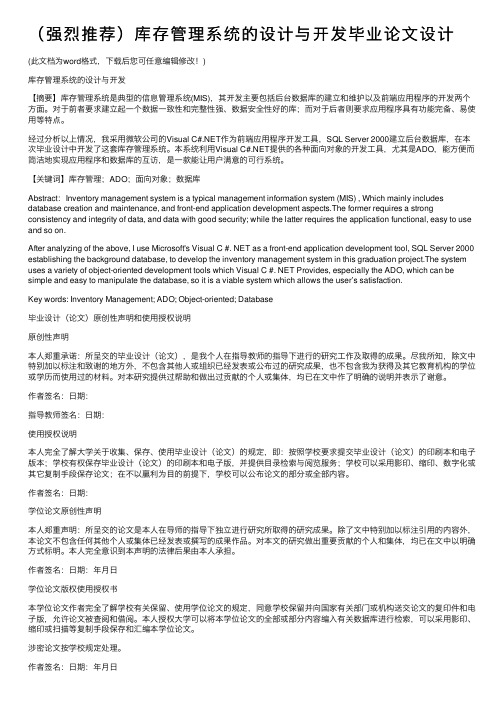
(强烈推荐)库存管理系统的设计与开发毕业论⽂设计(此⽂档为word格式,下载后您可任意编辑修改!)库存管理系统的设计与开发【摘要】库存管理系统是典型的信息管理系统(MIS),其开发主要包括后台数据库的建⽴和维护以及前端应⽤程序的开发两个⽅⾯。
对于前者要求建⽴起⼀个数据⼀致性和完整性强、数据安全性好的库;⽽对于后者则要求应⽤程序具有功能完备、易使⽤等特点。
经过分析以上情况,我采⽤微软公司的Visual C#.NET作为前端应⽤程序开发⼯具,SQL Server 2000建⽴后台数据库,在本次毕业设计中开发了这套库存管理系统。
本系统利⽤Visual C#.NET提供的各种⾯向对象的开发⼯具,尤其是ADO,能⽅便⽽简洁地实现应⽤程序和数据库的互访,是⼀款能让⽤户满意的可⾏系统。
【关键词】库存管理;ADO;⾯向对象;数据库Abstract:Inventory management system is a typical management information system (MIS) , Which mainly includes database creation and maintenance, and front-end application development aspects.The former requires a strong consistency and integrity of data, and data with good security; while the latter requires the application functional, easy to use and so on.After analyzing of the above, I use Microsoft's Visual C #. NET as a front-end application development tool, SQL Server 2000 establishing the background database, to develop the inventory management system in this graduation project.The system uses a variety of object-oriented development tools which Visual C #. NET Provides, especially the ADO, which can be simple and easy to manipulate the database, so it is a viable system which allows the user’s satisfaction.Key words: Inventory Management; ADO; Object-oriented; Database毕业设计(论⽂)原创性声明和使⽤授权说明原创性声明本⼈郑重承诺:所呈交的毕业设计(论⽂),是我个⼈在指导教师的指导下进⾏的研究⼯作及取得的成果。
毕业设计(论文)-在线服装销售管理系统设计与实现[管理资料]
![毕业设计(论文)-在线服装销售管理系统设计与实现[管理资料]](https://img.taocdn.com/s3/m/14d3528d27284b73f34250ef.png)
毕业设计说明书在线服装销售管理系统设计与实现专业计算机科学与技术学生姓名班级B计算机063学号指导教师完成日期2010年6月8日在线服装销售管理系统设计与实现摘要:随着互联网技术的发展以及电子商务的兴起,网络已成为一种全新的服装销售渠道。
网上服装销售量增长迅速,网上服装销售在整个服装销售中所占比例将会越来越高。
与传统的服装销售模式相比较,网上服装销售拥有许多不可比拟的优越性。
这是一个基于Internet,并根据现有的网上购物系统的现状而设计开发的电子商务平台。
它不但可以扩大商家的规模和市场影响力,而且可以减少企业的经营成本,提高工作效率。
首先介绍电子商务系统的现状及开发背景,然后论述了系统的设计目标,系统需求和总体设计方案,较详细的论述了系统的详细设计和实现。
最后,对网上购物系统进行了系统检测并提出了还需要改进的问题。
本系统主要由前台商品展示、销售和后台管理两部分组成。
前台部分主要包括商品查询、购物车、会员资料修改、订单查询、留言板,以及购物指南;后台管理部分主要对一些基础数据进行有效管理,包括商品管理、管理员管理、订单管理、留言管理等。
在设计方面,系统采用B/S三层结构,用Struts+Hibernate二大框架的结合开发,用到MySQL 数据库和Tomcat服务器,这些技术和支持都能比较好的融合在一起,技术相对比较成熟,能开发出稳定的系统。
关键词:电子商务;服装;网络;购物The Design and Implementation of Online Clothing SalesManagement SystemAbstract:With the growth of internet technology and electronic commerce,web site has become a fashionable medium for clothing number of online clothing sales rapidly rises,representing an increasingly large proportion of total with traditional sales model,online transaction has incomparable system is based on the Internet,and in accordance with the existing system,the status of online shopping and the design and development of e-commerce can not only enhance the scale of shopping centre and market influence,and can also reduce the enterprise’s running cost,improve work introduced the status of E-commerce systems and development background,and then discusses the system design objectives,system requirements and design program,more detailed discussion of the detailed design of the system and ,conclusion has been drawn about the system and the problem has also been system is composed of two parts:foreground display of commodity and product sales,and background first part includes produc- ts information,shopping cars,membership correction,order inquiries,messages board,and shopping second part is responsible for the management of some basic data,in- cluding the management of commodities,administrator,orders,and of the design,system uses B/S three-tier structure,with Struts+Hibernate framework for the integ- ration of the three major system use the MySQL database,and the Tomcat supporting and technologies can work better together,and the technology is relatively matured,which can develop a stable system.Key words: Electronic Commerce;Clothes;Network;Shopping;目录1 概述 (1)2 系统需求分析及开发工具 (1)系统需求分析 (1)系统开发工具 (3)3 系统总体设计 (5)总体结构及功能简介 (5)数据库设计 (10)4 主要功能模块详细设计 (16)用户模块 (16)商品模块设计 (18)购物车模块设计 (21)订单模块设计 (21)留言板模块设计 (22)管理员管理模块设计 (24)5 系统测试与维护 (26)系统测试 (26)系统维护 (28)6 结束语 (29)参考文献 (30)致谢 (30)附录 (31)附录1 源程序清单 (31)管理员模块 (31)商品模块 (33)用户模块 (38)留言模块 (39)订单模块 (42)购物车模块 (46)在线服装销售管理系统设计与实现1 概述近年来,随着Internet的迅速崛起,互联网已日益成为收集提供信息的最佳渠道并逐步进入传统的流通领域。
计算机本科毕业论文服装销售网站的设计与实现资料
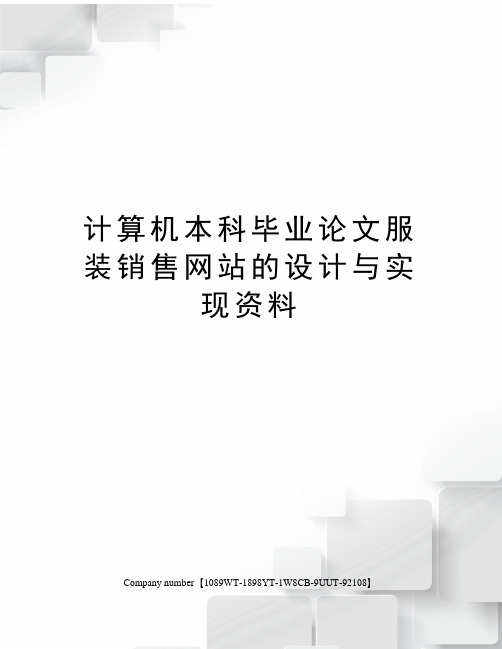
计算机本科毕业论文服装销售网站的设计与实现资料Company number【1089WT-1898YT-1W8CB-9UUT-92108】【最新资料,WORD文档,可编辑修改】雪雅服饰的设计与实现摘要随着计算机的普及应用,我们已经进入了一个信息化、数字化的大数据时代。
随着大数据时代的到来各行各业都在逐步走向信息化、数据化。
传统的零售行业也开始转型走向互联网销售,原来我们基于纸质的数据和资料逐渐被电子方式所替代。
而且我们通过计算机对线上销售平台进行管理具有线下操作无法匹及的优点。
例如:检索迅速、存储量大、高效率、寿命长、低成本、方便快捷等,这些优点能够极大地提高管理和办事的效率。
而且只要系统的设计合理,我们就可以通过网络的互动、资源共享等优点,加之传统的销售优点,从而使互联网销售更人性化、规范化、个性化。
本系统是在Windows平台下,用JSP、网络编程、Struts、Spring、hibernate等技术,结合My SQL数据库管理系统开发出的B/S结构的在线服装销售系统网站。
动态网页与静态网页相结合的方法制作此系统,为了降低网站维护的工作量,为了使系统可以实现更多的功能,为了实现网站与客户之间的交流和沟通,系统的页面采用数据库技术作为支持,该系统实现了用户登录、服装的查询、购买、用户的注册及管理员对系统的管理等功能。
Design and implementation of xueya clothing AbstractWith the popularization of computers, we have entered a information technology, digital era of big data. With the advent of the era of big data businesses are gradually moving towards information technology, data technology. Traditional retail industry began the transition to Internet sales, that we have been gradually replaced by electronic means paper-based data and information. And we have a computer for online sales platform for management advantages of operating with a line and the horses. For example: therapid retrieval, storage capacity, high efficiency, long life, low cost, convenient, etc. These advantages cangreatly improve the management and efficiency of work. And as long as the design of the system is reasonable, we can, through interaction and resource sharing network advantages, combined with the advantages of traditional sales, making Internet sales more humane, standardized and personalized.This system is under the Windows platform, with JSP, network programming, Struts, Spring, hibernate technology, combined with My SQL database management system to develop a B / S structure of online clothing sales system website. Dynamic pages and static pages combining method of making this system, in order to reduce the site maintenance workload, in order to make the system more functionality can be achieved, in order to achieve the exchange and communication between the customer site, the system uses database technology as a page support, the system enables users to log in, clothes inquiries, purchase, userregistration and administrator of the system management functions.Keywords: Clothing; Struts; Spring; Hibernate;目录引言1.1 选题背景近几年来,电子商务行业、互联网行业、移动终端的迅速发展,使我们进入了新的时代——大数据时代。
毕业论文《库存管理系统》

毕业论文《库存管理系统》一、引言库存管理是企业物流管理的一个重要组成部分,它的质量和效率直接关系到企业的生产经营及市场竞争力。
因此,现代企业需要建立高效的库存管理系统,实时掌握库存状况,减少库存成本,提高库存周转率,提高企业经济效益。
针对目前市面上的库存管理系统存在不足之处,本文将介绍一款基于WEB平台的库存管理系统的设计与实现。
二、系统需求分析1.基本需求(1)系统支持多用户同时进行操作,具有权限控制和用户管理功能。
(2)系统具有基本的库存管理功能,能够添加商品和仓库信息,对商品进行入库、出库和库存查询。
(3)系统能够自动生成库存报表和各类统计报表,包括仓库容量使用情况、商品销售情况等。
2.扩展需求(1)系统支持移动端使用,在手机、平板等移动设备上实现库存管理功能。
(2)系统能够自动更新库存数据,当商品被借出或归还时实时更新库存数据。
(3)系统支持三方数据对接,能够与外部ERP系统进行数据交互。
三、系统设计与实现1.系统架构本系统分为三层结构:前端展示层、中间业务层和数据管理层。
前端展示层使用HTML、CSS和JavaScript等技术实现用户界面,展示库存信息和实现用户操作。
中间业务层使用Java语言和Spring框架实现业务逻辑,包括商品管理、入库、出库等功能。
数据管理层使用MySQL实现数据的存储和管理。
2.系统模块设计(1)用户模块:实现用户注册、登录、权限控制和密码修改等功能。
(2)商品模块:实现商品信息的添加、查询和修改等功能。
(3)库存模块:实现商品入库、出库和库存查询等功能。
同时可以导出库存报表。
(4)报表模块:自动生成各类报表,包括仓库容量使用情况、商品销售情况等。
(5)移动端模块:实现移动端库存管理功能,在手机、平板等移动设备上实现操作。
四、系统实现效果本系统实现了多用户同时使用,有权限控制和用户管理功能。
商品信息可以自由添加、查询和修改。
库存管理功能可以实现入库、出库和库存查询等功能,并生成库存报表和统计报表。
仓库管理系统界面设计web
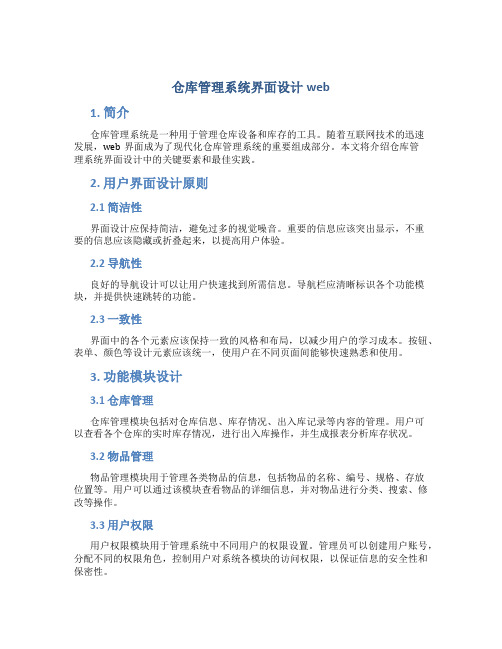
仓库管理系统界面设计web1. 简介仓库管理系统是一种用于管理仓库设备和库存的工具。
随着互联网技术的迅速发展,web界面成为了现代化仓库管理系统的重要组成部分。
本文将介绍仓库管理系统界面设计中的关键要素和最佳实践。
2. 用户界面设计原则2.1 简洁性界面设计应保持简洁,避免过多的视觉噪音。
重要的信息应该突出显示,不重要的信息应该隐藏或折叠起来,以提高用户体验。
2.2 导航性良好的导航设计可以让用户快速找到所需信息。
导航栏应清晰标识各个功能模块,并提供快速跳转的功能。
2.3 一致性界面中的各个元素应该保持一致的风格和布局,以减少用户的学习成本。
按钮、表单、颜色等设计元素应该统一,使用户在不同页面间能够快速熟悉和使用。
3. 功能模块设计3.1 仓库管理仓库管理模块包括对仓库信息、库存情况、出入库记录等内容的管理。
用户可以查看各个仓库的实时库存情况,进行出入库操作,并生成报表分析库存状况。
3.2 物品管理物品管理模块用于管理各类物品的信息,包括物品的名称、编号、规格、存放位置等。
用户可以通过该模块查看物品的详细信息,并对物品进行分类、搜索、修改等操作。
3.3 用户权限用户权限模块用于管理系统中不同用户的权限设置。
管理员可以创建用户账号,分配不同的权限角色,控制用户对系统各模块的访问权限,以保证信息的安全性和保密性。
4. 界面设计示例# 仓库管理系统## 仓库管理- 仓库1- 当前库存:100- 出入库记录- 入库:50- 出库:20- 仓库2- 当前库存:200- 出入库记录- 入库:80- 出库:30## 物品管理- 物品1- 编号:001- 规格:大号- 存放位置:A1- 物品2- 编号:002- 规格:中号- 存放位置:B2## 用户权限- 用户1- 角色:管理员- 权限:全权限- 用户2- 角色:普通用户- 权限:查看权限5. 结论仓库管理系统界面设计对于提高用户的工作效率和体验至关重要。
通过保持界面的简洁性、导航性和一致性,以及合理设计各功能模块,可以帮助用户快速定位所需信息,提高工作效率,降低操作错误率,从而提升整体管理效果。
毕业设计服饰网上商店系统设计
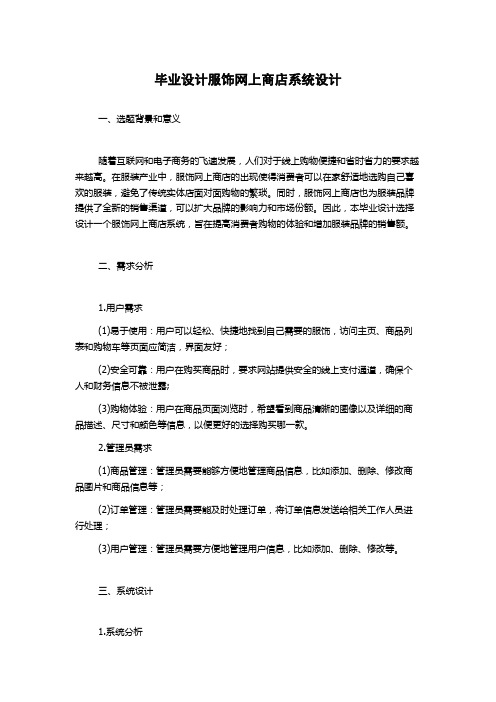
毕业设计服饰网上商店系统设计一、选题背景和意义随着互联网和电子商务的飞速发展,人们对于线上购物便捷和省时省力的要求越来越高。
在服装产业中,服饰网上商店的出现使得消费者可以在家舒适地选购自己喜欢的服装,避免了传统实体店面对面购物的繁琐。
同时,服饰网上商店也为服装品牌提供了全新的销售渠道,可以扩大品牌的影响力和市场份额。
因此,本毕业设计选择设计一个服饰网上商店系统,旨在提高消费者购物的体验和增加服装品牌的销售额。
二、需求分析1.用户需求(1)易于使用:用户可以轻松、快捷地找到自己需要的服饰,访问主页、商品列表和购物车等页面应简洁,界面友好;(2)安全可靠:用户在购买商品时,要求网站提供安全的线上支付通道,确保个人和财务信息不被泄露;(3)购物体验:用户在商品页面浏览时,希望看到商品清晰的图像以及详细的商品描述、尺寸和颜色等信息,以便更好的选择购买哪一款。
2.管理员需求(1)商品管理:管理员需要能够方便地管理商品信息,比如添加、删除、修改商品图片和商品信息等;(2)订单管理:管理员需要能及时处理订单,将订单信息发送给相关工作人员进行处理;(3)用户管理:管理员需要方便地管理用户信息,比如添加、删除、修改等。
三、系统设计1.系统分析(1)需求分析:根据用户和管理员认为衍生出的各种需求,确定系统的设计方向;(2)功能分析:根据需求分析的结果,把整个系统拆分成相互独立的子系统,对其中的不同功能进行划分;(3)数据分析:对系统中需要处理的数据进行分析,设计出存储数据的结构。
2.系统架构设计(1)前端设计:采用HTML、CSS、JavaScript等技术来实现用户与系统的交互操作;(2)后台设计:采用PHP、Java、Python等技术来实现系统的核心功能,包括用户登录、商品管理、订单管理等。
3.数据库设计根据需求分析的结果,设计出合适的数据库结构,包括用户信息、商品信息、订单信息等。
4.系统模块设计(1)用户管理模块:用户进行注册、登录等相关操作;(2)商品管理模块:管理员进行商品的添加、删除和修改等相关操作;(3)购物车模块:用户可以将自己感兴趣的商品添加到购物车中,并进行结算;(4)订单管理模块:管理员可以查看订单信息,对已付款和未付款的订单进行处理。
服装行业库存管理系统设计方案

服装行业库存管理系统设计方案第一章引言 (2)1.1 项目背景 (2)1.2 项目目的与意义 (2)1.3 项目研究方法 (3)第二章库存管理概述 (3)2.1 库存管理基本概念 (3)2.2 库存管理的重要性 (3)2.3 库存管理的主要任务 (4)第三章服装行业库存管理现状分析 (4)3.1 服装行业库存管理现状 (4)3.2 服装行业库存管理存在的问题 (5)3.3 影响服装行业库存管理的因素 (5)第四章库存管理系统需求分析 (5)4.1 功能需求 (5)4.1.1 库存管理模块 (5)4.1.2 销售管理模块 (6)4.1.3 采购管理模块 (6)4.1.4 数据分析模块 (6)4.2 功能需求 (7)4.2.1 响应时间 (7)4.2.2 数据存储容量 (7)4.2.3 数据处理能力 (7)4.2.4 系统稳定性 (7)4.3 可行性分析 (7)4.3.1 技术可行性 (7)4.3.2 经济可行性 (7)4.3.3 运营可行性 (7)4.3.4 法律可行性 (7)第五章系统设计 (7)5.1 系统架构设计 (7)5.2 数据库设计 (8)5.3 模块设计 (8)第六章关键技术研究 (9)6.1 库存预测算法研究 (9)6.2 库存优化算法研究 (9)6.3 数据挖掘技术在库存管理中的应用 (10)第七章系统开发与实现 (10)7.1 开发环境与工具 (10)7.1.1 开发环境 (10)7.1.2 开发工具 (11)7.2 系统开发流程 (11)7.3 系统测试与优化 (11)7.3.1 测试策略 (11)7.3.2 测试执行 (12)7.3.3 优化策略 (12)第八章系统应用案例分析 (12)8.1 案例一:某服装企业库存管理现状 (12)8.1.1 企业背景 (12)8.1.2 库存管理现状 (12)8.2 案例二:某服装企业库存管理系统实施效果 (13)8.2.1 系统实施背景 (13)8.2.2 系统实施过程 (13)8.2.3 实施效果 (13)8.3 案例三:某服装企业库存管理改进措施 (13)8.3.1 加强库存数据管理 (13)8.3.2 优化库存调配策略 (13)8.3.3 提高员工素质 (13)8.3.4 加强库存预警机制 (13)第九章系统评价与改进 (13)9.1 系统功能评价 (14)9.2 系统功能评价 (14)9.3 系统改进方向 (14)第十章结论与展望 (15)10.1 研究结论 (15)10.2 研究局限 (15)10.3 研究展望 (16)第一章引言1.1 项目背景经济的快速发展,服装行业作为我国国民经济的重要组成部分,其市场规模逐年扩大。
基于javaweb的仓库管理系统设计与实现开题报告近5年10篇参考文献

基于javaweb的仓库管理系统设计与实现开题报告近5年10篇参考文献基于JavaWeb的仓库管理系统设计与实现开题报告一、研究背景和意义随着物流行业的快速发展,仓库管理系统在现代物流管理中起着至关重要的作用。
传统的仓库管理方式已经无法满足日益增长的需求,因此,基于JavaWeb的仓库管理系统的设计与实现具有重要的研究意义和实际应用价值。
二、研究目标和内容本研究的目标是设计和实现一个基于JavaWeb的仓库管理系统,以提高仓库管理的效率和准确性。
具体内容包括:需求分析、系统设计、数据库设计、系统实现等。
三、研究方法和步骤1. 需求分析:通过调研和访谈,了解用户对仓库管理系统的需求,并进行需求分析和功能设计。
2. 系统设计:根据需求分析结果,设计系统的整体架构和模块划分,确定系统的功能和界面设计。
3. 数据库设计:设计系统所需的数据库结构,包括仓库信息、货物信息、订单信息等。
4. 系统实现:使用JavaWeb技术,采用MVC模式进行系统的开发和实现,包括前端页面的设计和后端代码的编写。
5. 系统测试:对系统进行功能测试、性能测试和安全测试,确保系统的稳定性和可靠性。
6. 系统部署:将系统部署到服务器上,进行系统的上线运行和维护。
四、预期成果和创新点1. 预期成果:设计和实现一个功能完善、界面友好的基于JavaWeb的仓库管理系统,能够满足用户的需求,提高仓库管理的效率和准确性。
2. 创新点:采用JavaWeb技术进行系统的开发,具有良好的跨平台性和可扩展性;引入MVC模式进行系统的设计,提高系统的可维护性和可扩展性。
五、参考文献1. 张三, 李四. 基于JavaWeb的仓库管理系统设计与实现[J]. 计算机应用, 2015, 41(5): 100-105.2. 王五, 赵六. 基于JavaWeb的仓库管理系统的设计与实现[J]. 计算机工程与应用, 2016, 52(10): 80-85.3. 陈七, 马八. 基于JavaWeb的仓库管理系统的设计与实现[J]. 计算机科学与技术, 2017, 43(3): 120-125.4. 李九, 王十. 基于JavaWeb的仓库管理系统的设计与实现[J]. 信息技术, 2018, 54(7): 60-65.5. 刘十一, 张十二. 基于JavaWeb的仓库管理系统的设计与实现[J]. 计算机工程, 2019, 45(9): 90-95.6. 杨十三, 赵十四. 基于JavaWeb的仓库管理系统的设计与实现[J]. 计算机应用与软件, 2020, 46(6): 70-75.7. 周十五, 吴十六. 基于JavaWeb的仓库管理系统的设计与实现[J]. 计算机科学, 2021, 47(2): 110-115.8. 钱十七, 孙十八. 基于JavaWeb的仓库管理系统的设计与实现[J]. 计算机技术与发展, 2022, 48(1): 50-55.9. 杜十九, 朱二十. 基于JavaWeb的仓库管理系统的设计与实现[J]. 计算机应用技术, 2023, 49(4): 130-135.10. 胡二十一, 沈二十二. 基于JavaWeb的仓库管理系统的设计与实现[J]. 计算机工程与设计, 2024, 50(8): 100-105.六、研究计划1. 第一年:进行需求分析和系统设计,完成系统的整体架构和模块划分。
仓库管理系统毕业论文【范本模板】

仓库管理系统毕业论文【范本模板】一、摘要本文以仓库管理系统为研究对象,通过对我国企业仓库管理现状的分析,发现现有仓库管理存在的问题,并提出了一套基于现代信息技术的仓库管理系统设计方案。
本系统采用B/S架构,以Java为开发语言,运用MySQL数据库进行数据存储,实现了仓库的入库、出库、库存查询、库存预警等功能。
通过对系统的实际应用,验证了本系统在提高仓库管理效率、降低企业运营成本方面的有效性。
二、关键词:仓库管理;B/S架构;Java;MySQL;管理系统三、引言随着我国经济的快速发展,企业对仓库管理的要求越来越高。
传统的手工管理模式已无法满足现代企业的发展需求,因此,研究并开发一套高效、实用的仓库管理系统具有重要的现实意义。
本文旨在通过对仓库管理系统的设计与实现,为企业提供一种便捷、高效的仓库管理解决方案,从而提高企业的核心竞争力。
四、仓库管理现状及问题分析1. 仓库管理现状(1)手工操作:大部分企业仍采用手工方式进行仓库管理,效率低下,易出错。
(2)信息孤岛:仓库管理部门与其他部门之间信息不畅通,导致资源浪费。
(3)库存管理不规范:库存数据不准确,库存积压和缺货现象时有发生。
2. 存在的问题(1)管理效率低:手工操作导致仓库管理效率低下,影响企业整体运营。
(2)数据准确性差:手工记录易出错,导致库存数据不准确。
(3)资源浪费:信息孤岛现象导致企业资源无法合理配置。
五、仓库管理系统设计方案1. 系统目标(1)提高仓库管理效率,降低人力成本。
(2)实现库存数据的实时更新,确保库存准确性。
(3)消除信息孤岛,实现企业各部门之间的信息共享。
2. 系统架构本系统采用B/S架构,分为客户端和服务器端。
客户端负责用户界面展示,服务器端负责数据处理和存储。
3. 系统功能模块(1)入库管理:实现商品入库登记、入库审核等功能。
(2)出库管理:实现商品出库登记、出库审核等功能。
(3)库存查询:实时查询商品库存信息,支持库存预警。
服装库存管理系统数据库设计
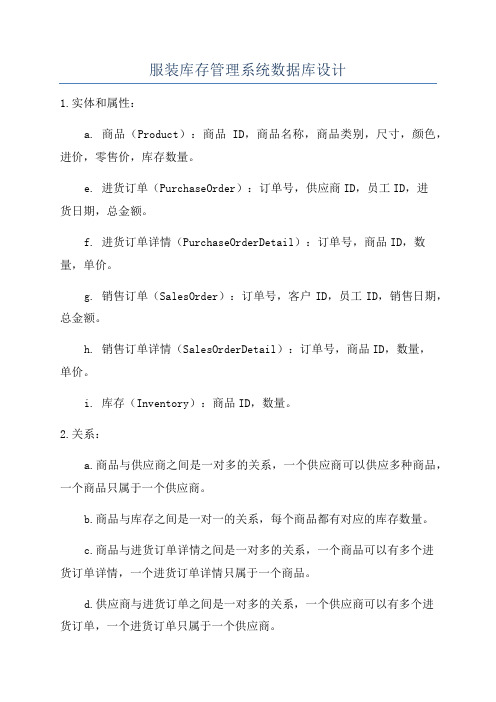
服装库存管理系统数据库设计1.实体和属性:a. 商品(Product):商品ID,商品名称,商品类别,尺寸,颜色,进价,零售价,库存数量。
e. 进货订单(PurchaseOrder):订单号,供应商ID,员工ID,进货日期,总金额。
f. 进货订单详情(PurchaseOrderDetail):订单号,商品ID,数量,单价。
g. 销售订单(SalesOrder):订单号,客户ID,员工ID,销售日期,总金额。
h. 销售订单详情(SalesOrderDetail):订单号,商品ID,数量,单价。
i. 库存(Inventory):商品ID,数量。
2.关系:a.商品与供应商之间是一对多的关系,一个供应商可以供应多种商品,一个商品只属于一个供应商。
b.商品与库存之间是一对一的关系,每个商品都有对应的库存数量。
c.商品与进货订单详情之间是一对多的关系,一个商品可以有多个进货订单详情,一个进货订单详情只属于一个商品。
d.供应商与进货订单之间是一对多的关系,一个供应商可以有多个进货订单,一个进货订单只属于一个供应商。
e.员工与进货订单之间是一对多的关系,一个员工可以有多个进货订单,一个进货订单只属于一个员工。
f.客户与销售订单之间是一对多的关系,一个客户可以有多个销售订单,一个销售订单只属于一个客户。
g.员工与销售订单之间是一对多的关系,一个员工可以有多个销售订单,一个销售订单只属于一个员工。
h.商品与销售订单详情之间是一对多的关系,一个商品可以有多个销售订单详情,一个销售订单详情只属于一个商品。
i.销售订单与库存之间是多对多的关系,一个销售订单可以有多个库存,一个库存可以属于多个销售订单。
3.数据库表结构设计:a. 商品表(Product):商品ID(主键),商品名称,商品类别,尺寸,颜色,进价,零售价。
e. 进货订单表(PurchaseOrder):订单号(主键),供应商ID(外键),员工ID(外键),进货日期,总金额。
毕业论文--基于JavaWeb的网络购物中心系统的实现
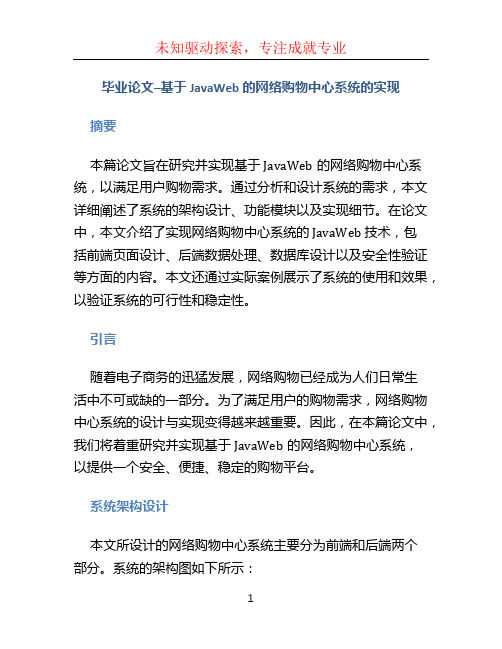
毕业论文–基于JavaWeb的网络购物中心系统的实现摘要本篇论文旨在研究并实现基于JavaWeb的网络购物中心系统,以满足用户购物需求。
通过分析和设计系统的需求,本文详细阐述了系统的架构设计、功能模块以及实现细节。
在论文中,本文介绍了实现网络购物中心系统的 JavaWeb 技术,包括前端页面设计、后端数据处理、数据库设计以及安全性验证等方面的内容。
本文还通过实际案例展示了系统的使用和效果,以验证系统的可行性和稳定性。
引言随着电子商务的迅猛发展,网络购物已经成为人们日常生活中不可或缺的一部分。
为了满足用户的购物需求,网络购物中心系统的设计与实现变得越来越重要。
因此,在本篇论文中,我们将着重研究并实现基于JavaWeb的网络购物中心系统,以提供一个安全、便捷、稳定的购物平台。
系统架构设计本文所设计的网络购物中心系统主要分为前端和后端两个部分。
系统的架构图如下所示:系统架构图系统架构图•前端部分:前端采用HTML、CSS、JavaScript等技术实现网页展示和用户交互。
•后端部分:后端采用JavaWeb技术实现,包括用户管理、商品管理、订单管理等功能模块。
功能模块设计本文中的网络购物中心系统主要具备以下功能模块:用户模块•用户注册:用户可以填写相关个人信息并注册成为系统的会员。
•用户登录:已注册的用户可以通过输入用户名和密码进行登录操作。
•用户信息管理:用户可以修改个人信息、查看订单记录等。
商品模块•商品浏览:用户可以通过商品分类、关键字等方式进行商品的浏览。
•商品搜索:用户可以根据关键字搜索相关的商品。
•商品详情:用户可以查看商品的详细信息、价格等。
订单模块•购物车功能:用户可以将感兴趣的商品添加至购物车,随时查看和管理购物车内容。
•购买功能:用户可选择购买商品并完成订单的生成,包括选择收货地址、付款等操作。
•订单管理:用户可以查看已购买的订单记录,进行退货、申请退款等操作。
后台管理模块•商品管理:管理员可以对商品进行添加、修改、删除等操作。
基于Web的服装销售信息管理系统的分析与设计中期报告
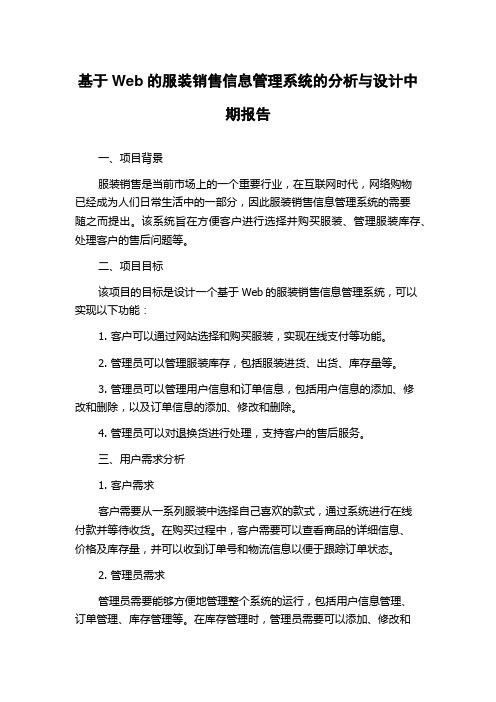
基于Web的服装销售信息管理系统的分析与设计中期报告一、项目背景服装销售是当前市场上的一个重要行业,在互联网时代,网络购物已经成为人们日常生活中的一部分,因此服装销售信息管理系统的需要随之而提出。
该系统旨在方便客户进行选择并购买服装、管理服装库存、处理客户的售后问题等。
二、项目目标该项目的目标是设计一个基于Web的服装销售信息管理系统,可以实现以下功能:1. 客户可以通过网站选择和购买服装,实现在线支付等功能。
2. 管理员可以管理服装库存,包括服装进货、出货、库存量等。
3. 管理员可以管理用户信息和订单信息,包括用户信息的添加、修改和删除,以及订单信息的添加、修改和删除。
4. 管理员可以对退换货进行处理,支持客户的售后服务。
三、用户需求分析1. 客户需求客户需要从一系列服装中选择自己喜欢的款式,通过系统进行在线付款并等待收货。
在购买过程中,客户需要可以查看商品的详细信息、价格及库存量,并可以收到订单号和物流信息以便于跟踪订单状态。
2. 管理员需求管理员需要能够方便地管理整个系统的运行,包括用户信息管理、订单管理、库存管理等。
在库存管理时,管理员需要可以添加、修改和删除服装,实时更新服装的库存量信息,并且及时更新服装价格、折扣信息,同时系统还需要提供自动化的出入库记录。
在订单管理时,管理员需要能够查看订单历史记录、订单状态,还需要能够处理退换货请求和投诉。
在用户信息管理时,管理员需要可以添加、修改和删除用户信息,并且可以查看用户的订单历史记录以及账户余额。
四、系统设计该系统采用MVC模式设计,将用户界面、业务逻辑和数据存储分离开来。
其核心架构包括以下几个模块:1. 用户模块:负责处理用户的注册、登录、购买、评论等用户行为。
2. 商品展示模块:提供一系列服装图片,包括服装的图片和详细说明,可以方便客户浏览、选择和购买。
3. 支付模块:提供一种方便、安全和可靠的在线支付服务,包括主流的支付方式(支付宝、微信支付等)。
本科毕业设计论文--某服装有限公司网站的设计与实现计算机应用专业
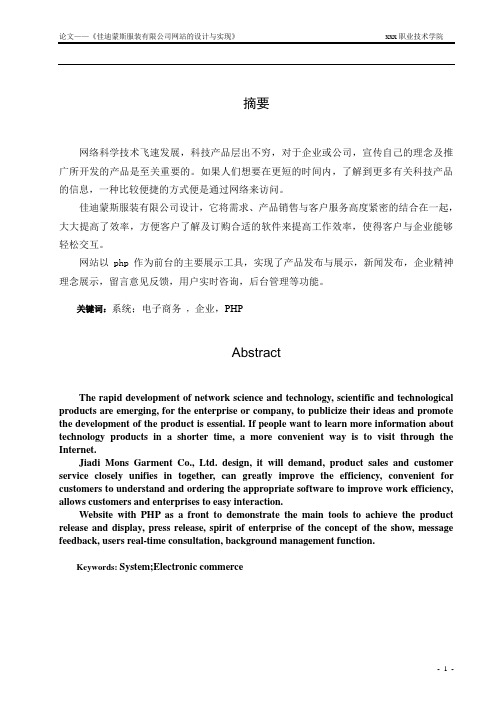
摘要网络科学技术飞速发展,科技产品层出不穷,对于企业或公司,宣传自己的理念及推广所开发的产品是至关重要的。
如果人们想要在更短的时间内,了解到更多有关科技产品的信息,一种比较便捷的方式便是通过网络来访问。
佳迪蒙斯服装有限公司设计,它将需求、产品销售与客户服务高度紧密的结合在一起,大大提高了效率,方便客户了解及订购合适的软件来提高工作效率,使得客户与企业能够轻松交互。
网站以php作为前台的主要展示工具,实现了产品发布与展示,新闻发布,企业精神理念展示,留言意见反馈,用户实时咨询,后台管理等功能。
关键词:系统;电子商务,企业,PHPAbstractThe rapid development of network science and technology, scientific and technological products are emerging, for the enterprise or company, to publicize their ideas and promote the development of the product is essential.If people want to learn more information about technology products in a shorter time, a more convenient way is to visit through the Internet.Jiadi Mons Garment Co., Ltd. design, it will demand, product sales and customer service closely unifies in together, can greatly improve the efficiency, convenient for customers to understand and ordering the appropriate software to improve work efficiency, allows customers and enterprises to easy interaction.Website with PHP as a front to demonstrate the main tools to achieve the product release and display, press release, spirit of enterprise of the concept of the show, message feedback, users real-time consultation, background management function.Keywords:System;Electronic commerce目录第1章绪论 (2)1.1 问题的提出 (2)1.2 研究目的............................................................................................... 错误!未定义书签。
毕业设计-库存管理系统的设计与实现

毕业设计-库存管理系统的设计与实现(总24页)--本页仅作为文档封面,使用时请直接删除即可----内页可以根据需求调整合适字体及大小--库存管理系统的设计与实现摘要库存管理是企业管理的重要组成部分。
在企业生产经营活动中,库存管理既必须保证生产车间对原材料、零部件需求,又直接影响采购、销售部门的购、销活动。
本文主要从系统需求分析、系统结构,功能模块划分,系统设计方面进行说明。
系统基于B/S模式,采用ASP和SQL Server2000数据库系统来实现物品信息管理,库存警示,信息查询,留言版等功能。
本系统完全符合信息管理系统的要求,并且系统从需求分析、概要设计、详细设计到具体代码实现和后期的功能测试都严格遵循了软件工程的思想。
关键词:库存管理;数据库;信息管理;B/S模式;ASPThe Design and Implementation of the Stock Management SystemAbstractStock management is an important component of the enterprises management. In enterprise production and business activities, stock management must ensure the production workshops demand spare parts of the raw materials, and directly affect the activities of the purchasing and sales departments. This paper has analyzed the stock management system basic functions and composition of the system, including requirements analysis, system structure, function modules, and system design explanation. The system bases on B/S model and uses ASP and SQL Server 2000 database system to achieve articles information management, stock warning, statistic and inquiry, message boards and other functions. The system fully complies with the information management system. And requirements from the system analysis, the outline design, detailed design, implementation of the functional test, the development process strictly adhered to the ideas of software engineering.Key words: Stock Management; Database; Information Management; B/S Model; ASP目录论文总页数:23页1 引言............................................................................................................错误!未定义书签。
库存管理系统毕业设计论文(本科)
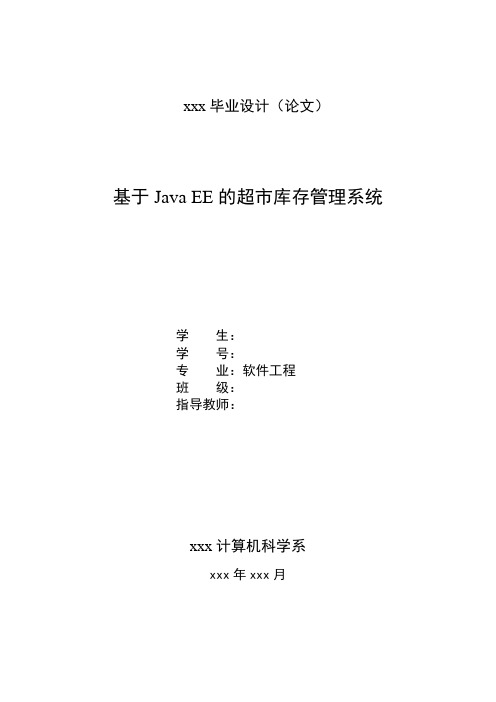
xxx毕业设计(论文)基于Java EE的超市库存管理系统学生:学号:专业:软件工程班级:指导教师:xxx计算机科学系xxx年xxx月毕业设计(论文)任务书设计(论文)题目:基于Java EE的超市库存管理系统系:计算机科学系专业:软件工程班级: 学号: 1xxxx学生: xxx 指导教师: xxx接受任务时间教研室主任(签名)系主任(签名)1.毕业设计(论文)的主要内容及基本要求本课题采用优秀的Java EE中的ssh高级框架整合技术来应用开发,后台管理中需要实现进货管理、销售管理、库存管理、日常管理以及系统管理等其它功能。
在进货管理和销售管理中需要实现库存、进销退货、财务等的相关查询操作。
库存管理需要完成对库存商品进行预警、盘点、报损、基本统计等功能。
而日常管理和系统管理需要对客户、商品、供应商、员工以及系统等资料进行操作。
本课题需要首先对ssh整合框架的基本原理有较深入的了解,熟悉Java EE中相关的XML、JavaScript、JSP等理论,能熟练地在MyEclipse的环境下创建Web project。
要设计出完善合理的数据库,并能熟练使用hibernate框架技术操作数据库。
要用JSP编写出后台需要操作管理的用户界面,通过JavaScripet技术控制用户界面数据合法录入。
在Java EE中,要充分利用ssh框架提供的通用、灵活、开放、可重用和可扩展等优点来解决项目规模和复杂性的提高。
要能熟悉使用Struts2管理用户请求并作出响应,通过JavaScript和Action对用户界面进行控制,实现界面的友好交互和易操作功能。
要按要求遵循软件工程的方法、需求分析、设计和编码规范等工作。
使系统做到效率高、可靠、易操作、安全性强、用户界面友好等。
要完成必要的程序开发工作和开发文档。
最后要提交数据库、源程序、开发文档及论文。
2.指定查阅的主要参考文献及说明[1]王岚.数据库系统原理.北京:清华大学出版社,2010.6[2]彭龚.软件工程.重庆:重庆大学出版社,2011.2基于Java EE的超市库存管理系统摘要随着社会和科学技术的发展,超市对库存管理的方法也发生了很大的改变。
基于web的仓库管理系统的设计与实现

基于web的仓库管理系统的设计与实现基于Web的仓库管理系统(Web-based Warehouse Management System, WMS)是一种通过互联网访问的应用程序,用于管理和控制仓库内的存储、移动和库存跟踪。
这种系统使得用户可以通过任何具有网络连接的设备进行操作,提高了灵活性和效率。
以下是设计和实现基于Web的仓库管理系统的基本步骤:一、需求分析1. 确定需求:与利益相关者沟通以了解他们的需求和预期。
2. 业务流程:分析现有的业务流程或创建新的业务流程图。
3. 功能要求:列出系统必须具备的功能特性。
4. 技术要求:确定所需的技术标准,如服务器规格、数据库、编程语言等。
二、系统设计1. 概念设计:制定整体架构,包括系统的模块划分和它们之间的关系。
2. 数据模型设计:设计数据库结构,确保所有数据需求得到满足。
3. 界面设计:设计用户界面,使其直观易用。
4. 技术架构:选择合适的前端和后端框架、数据库和其他技术栈。
三、开发1. 环境搭建:配置开发环境,包括安装必要的软件和工具。
2. 编码实现:按照设计文档编写代码实现系统功能。
(1)前端开发:使用HTML, CSS, JavaScript及框架(如React, Angular, Vue.js)构建用户界面。
(2)后端开发:使用服务器端语言(如Python, Java, PHP, Node.js)和框架(如Django, Spring, Laravel)处理业务逻辑。
(3)数据库实施:根据设计建立数据库,并进行数据的输入和管理。
3. 接口开发:开发APIs以供前端调用,实现前后端分离。
四、测试1. 单元测试:测试单独的组件或方法以确保它们正常工作。
2. 集成测试:测试组件间的交互是否正确。
3. 系统测试:全面测试整个系统的功能。
4. 性能测试:确保系统能够处理预期的负载。
5. 安全测试:确保系统的安全性,防止未授权访问和数据泄露。
五、部署1. 准备生产环境:配置服务器、数据库和其他必要的服务。
- 1、下载文档前请自行甄别文档内容的完整性,平台不提供额外的编辑、内容补充、找答案等附加服务。
- 2、"仅部分预览"的文档,不可在线预览部分如存在完整性等问题,可反馈申请退款(可完整预览的文档不适用该条件!)。
- 3、如文档侵犯您的权益,请联系客服反馈,我们会尽快为您处理(人工客服工作时间:9:00-18:30)。
北方民族大学学士学位论文论文题目:基于Web2.0的服装库存管理系统设计院(部)名称:计算机科学与工程学院学生姓名:专业:学号:指导教师姓名:论文提交时间: 2016年5月10日论文答辩时间: 2016年5月15日学位授予时间:北方民族大学教务处制基于Web2.0的服装库存管理系统设计摘要本系统是基于B/S的web系统,使用spingMVC使各层分离。
前台页面部分使用了Jsp、css、easyUI、JavaScript、jquery等技术,开发过程中使用SSH 框架,使用这些技术主要是为了便于系统的后期维护。
服装库存系统的开发目的是改进当前手工管理方式,提高工作效率。
基本数据管理可以将出入库的服装、仓库、客户信息进行管理,将出入库所涉及到的信息进行统一管理,避免了原本手工管理方式可能造成的错误信息录入。
通过出入库单与出入库单明细操作,可以清晰了解每单具体过程信息,责任到个人,保证了工作的准确性与效率。
关键词:服装库存系统,SSH,B/SDesign of clothing inventory management system basedon Web2.0AbstractThe system is based on the web of the B/S system, using spingMVC to make each layer of separation. The front page part of the use of Jsp, CSS, easyUI, JavaScript, jQuery and other technologies, the development process using the SSH framework, the use of these technologies is mainly in order to facilitate the late system maintenance.The development goal of clothing inventory system is to improve the current manual management mode and improve the efficiency of the work. Management of basic data to the storage of clothing, warehouse, customer information management, will be out of storage involves information for unified management, to avoid the original manual management mode may cause the error information input. Through a single storage and warehousing single operation details, we can clearly understand each specific process information, the responsibility to the individual, to ensure the accuracy and efficiency of the work.Key words: clothing inventory system, SSH, B/S目录第1章项目背景 (1)1.1服装库存管理现状 (1)1.1.1传统管理流程分析 (1)1.1.2新型信息化方向分析 (1)1.2选题的目的与意义 (1)1.3本次课题的成果 (2)第2章可行性研究与需求分析 (3)2.1系统需求分析 (3)2.2 可行性研究 (3)2.2.1 技术可行性 (3)2.2.2 资金可行性 (3)2.2.3 操作可行性 (4)2.2.4 法律可行性 (4)2.3系统实现目标 (4)2.4系统整体需求规定 (4)2.4.1数据处理要求 (4)2.4.2数据库能力要求 (4)2.4.3故障处理要求 (4)2.4.4运行环境要求 (5)第3章开发技术与环境选择 (6)3.1 J2EE概述 (6)3.2 Hibernate框架概述 (6)3.2.1 Hibernate简述 (7)3.2.2 Hibernate的优点 (7)3.3 Spring概述 (8)3.4系统架构 (8)第4章系统详细设计 (9)4.1数据库设计 (9)4.1.1 功能模块图 (9)4.1.2 数据库表设计 (9)4.2类设计 (11)4.2.1 实体类 (11)4.2.2 Action类 (11)4.3界面设计 (17)4.3.1 登录 (17)4.3.2 主界面 (17)4.3.3 基本数据管理 (17)4.3.4入库管理 (20)4.3.5出库管理 (21)4.3.6库存管理 (22)4.3.7系统管理 (23)4.4项目代码层次结构 (25)第5章系统的调试与测试 (27)5.1测试目的 (27)5.2功能测试及结果 (27)总结 (29)致谢 (30)参考文献 (31)第1章项目背景1.1服装库存管理现状随着社会的进步,经济的发展,各行各业有了很大的进步,越来越多的企业和组织出现,促进了经济与社会的发展,给社会创造了巨大的财富价值。
但是,大部分企业组织还是使用原始的手工管理方式,就目前情况来看,传统管理方式已经跟不上时代潮流,大量的人力物力被繁琐的日常事务所浪费。
而互联网技术却可以改进这些弊端,通过网络的方式,简化操作,提高效率。
因此,互联网技术月日常事务管理融合是一种趋势。
1.1.1传统管理流程分析传统的管理方法,通常将所有信息记录于纸质文件,然后将所有记录好的文件按各自分类归放入档案室,随着时间的增加,数据信息越来越多,管理越来越麻烦,档案的查询也成为一个问题,精确查找纸质文件存储信息也是非常不容易的,假如你想查询某天的入库信息,按照目前的存档方式,你必须通过查找大量的信息进行检索,查询流程又格外复杂,而且你可能查询不到日期比较久的记录。
另一方面,日常事务的管理主要通过签字审批纸质文件来进行,这样不仅仅耗费了大量人力物力,同时效率格外低下,受影响因素太多,环境的不同,领导出席情况,都会使得审批不能顺利进行,下一步的工作就这样被耽搁。
经过调查分析发现传统的管理方法在许多方面存在严重不足,必须进行改进,以改变现有情况[1]。
1.1.2新型信息化方向分析随着近些年来互联网的发展,人们越来越认识到互联网技术给生活带来的便利,各行各业、各种工作都开始逐渐互联网化,通过网络的管理,实时进行监测操作,不仅保证了工作的快速完成,也提高了工作完美完成的几率,但是互联网化过程中也存在很多问题,需要更多的努力才能进一步完善[2]。
虽然互联网也存在各种各样问题,但不得不说它确实方便了人们的生活,成为人类发展不可或缺的一部分,所以将传统管理方式逐步转换成新型信息化是非常有必要且刻不容缓的。
1.2选题的目的与意义选题一方面通过调查传统服装库存管理现状,另一方面结合现有的互联网技术,通过分析,确认了可以将信息化技术运用到原始管理方式上,以改进管理方式,提高效率。
通过互联网技术弥补传统方式上的一些缺陷,使得服装库存管理更加便利,且不受到地域等限制[3],随时随地确认查询,确定企业工作进行情况,将原始的弊端进一步减少,减少企业组织在人力物力上的浪费,可以将节省的资源,用于其他促进公司发展。
1.3本次课题的成果本次毕业设计的整个过程,开发者从选题设计到开发,直到服装库存系统程序的实现,通过初期调研,到设计实现程序,对企业库存有一个了解,也了解了企业工作流程,最终达到将软件平台推广应用,并且可以进一步拓展功能,实现满足客户需求的目的。
本次设计已经初步完成所有基本功能[4],对于服装库存基础的入库出库逻辑性设计实现已经完成,系统已经可以执行此功能。
第2章可行性研究与需求分析2.1系统需求分析服装库存管理系统可以通过请求网页的方式实现服装出入库的在线管理,通过提交服装信息与提交出入库操作,实现服装的入库、出库以及具体信息的查询分析。
企业管理者在某条出入库信息出现错误的时候可以通过查询,快速了解具体操作信息,确定经办人责任,同时及时进行补救。
基本数据管理:通过网络请求登入管理系统,可以对出入库的服装信息进行新增修改删除,确保了服装信息的更新;可以对存储的仓库与要进行进货出货的客户信息的修改添加,保证了操作对象准确性,防止手工操作过程中错误导致进行对不存在的仓库或客户的交易要求。
服装入库管理:通过网络请求登入管理系统,可以查看某日的入库单信息与该入库单下所有详细入库服装明细,通过添加入库明细中衣服,实现了对应服装库存数量的变动。
服装出库管理:通过网络请求登入管理系统,可以查看某日的出库单信息与该出库单下所有详细出库服装明细,通过减少出库明细中衣服,实现了对应服装库存数量的变动。
库存管理:可以根据仓库、服装款式等不同条件的查询,获取到用户想要看到的库存情况,方便企业管理人查看现有服装资源。
系统管理:通过对现有登录人的不同权限,修改可进入本系统人的信息,同时为便于系统升级,此模块还可以进行功能页面的添加。
2.2 可行性研究可行性研究报告主要是为了应对项目开发实施过程中可能约到的各种问题,经过调查分析,预防或提前解决这些问题。
本系统从四方面进行了分析研究:2.2.1 技术可行性服装库存系统开发中,使用myeclipse作为开发工具[5],并且采用mysql进行后台数据库存储,使用目前比较通用的java语言进行编程。
编程整体使用ssh 框架简化了开发难度。
本系统的开发人员有一定的开发基础,对开发过程中使用的软件、技术有一定了解,因此,从技术上来说是可行的。
2.2.2 资金可行性本系统的开发主要是用于毕业设计课题的完成,因此开发过程中使用的硬件设备(如电脑),软件平台及其环境(window7、myeclipse、MySQL)均非常完善且为免费。
测试期间可见本机搭成服务器进行测试,开发完成后,为方便别人访问,可以将本机作为服务器,因此,从资金上来说是可行的。
2.2.3 操作可行性本系统前端页面框架使用Easyui[6]作为友好操作界面,其操作方面也非常简单。
用户使用本系统时仅仅需要简单学习就可以很快熟悉操作流程。
整个使用过程没有复杂的操作的操作流程,方面上手,因此操作上是可行的。
2.2.4 法律可行性本系统的开发最终目的是用于毕设,不会涉及到任何商业利益,更加不会触犯任何法律条款,因此在法律上是可行的。
